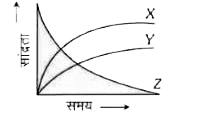Consider the following reactions : 2NO2(g)→2NO(g)+O2(g)
In the figure below, identify the curves X, Y and Z associated with the three species in the reaction
 Solution in Malayalam
Solution in Malayalam
X=NO,Y=O2,Z=NO2
X=O2,Y=NO,Z=NO2
X=NO2,Y=NO,Z=O2
X=O2,Y=NO2,Z=NO
The correct Answer is:A
The concentration of X is increasing hence it is product while concentration of Z decreases therefore it is reactant. The concentration of Y increases less than X that means production of Y is less than X. Hence, Y must be O2 and X must be NO because 2 mole of NO2 produces 2 mol of NO and 1 mol of O2. Therefore, X=NO,Y=O2 and Z=NO2.
Topper's Solved these Questions
- CHEMICAL AND IONIC EQUILIBRIUMBOOK - BRILLIANT PUBLICATIONCHAPTER - CHEMICAL AND IONIC EQUILIBRIUMEXERCISE - Level -II
52 Videos
- CHEMICAL AND IONIC EQUILIBRIUMBOOK - BRILLIANT PUBLICATIONCHAPTER - CHEMICAL AND IONIC EQUILIBRIUMEXERCISE - Level - III
19 Videos
- CHEMICAL AND IONIC EQUILIBRIUMBOOK - BRILLIANT PUBLICATIONCHAPTER - CHEMICAL AND IONIC EQUILIBRIUMEXERCISE - Questions
20 Videos
- CHEMICAL BONDINGBOOK - BRILLIANT PUBLICATIONCHAPTER - CHEMICAL BONDINGEXERCISE - LEVEL-III ( Linked Comprehension Type )
12 Videos
Similar Questions
For the following three reactions (i), (ii) and (iii), equilibrium constants are given:
i) CO(g)+H2O(g)⇔CO2(g)+H2(g),K1
ii) CH4(g)+H2O(g)⇔CO(g)+3H2(g),K2
iii) CH4(g)+2H2O(g)⇔CO2(g)+4H2(g),K3
Which of the following relation is correct?
View SolutionStarting with 1 mol of O2:2 mol of SO2, the equilibrium for the formation of SO3(g) was established a certain temperature. If V is the volume of the vessel and 2x is the number of moles of SO3 present, equilibrium constant for the reaction 2SO2(g)+O2(g)⇔2SO3(g) would be :
View SolutionThe equilibrium, concentration of H2,I2, and HI are respectively 5.0,3.0 and 17molL−1 . What will be the value of Kc for the reaction H2+I2 → 2HI ?
View SolutionIn an ionic bond, the cation tends to polarize the electron cloud of the anion by pulling electron dens towards itself. This causes development of covalent character in the ionic bond because the electron dens gets localised in-between the nuclei. The tendency of the cation to bring about the polarization of the anion expressed as its polarizing power. The ability of ion to undergo polarization is called its polarisability. The polarising power of a cation or an anion is decided on the basis of Fajans' rules.
The ionic conductance of which of the following is the highest?
View SolutionConsider the following reaction: 2NO_(2)(g) rarr 2NO(g)+ O_(2)(g) In the figure below, identify the curves X,Y, and Z associated with the three species in the reaction
View Solution2NO2(g)→2NO(g)+O2(g) For the reaction above, a straight line for which plot indicates a second order reaction ?
View SolutionAssertion : The reaction 2NO (g) + O_(2) (g) hArr 2NO_(2)(g) is favoured in the forward direction with increase of pressure. Reason : The reaction is exothermic.
View SolutionHow can you determine the rate law of the following reactions? 2NO(g) + O_(2)(g) to 2NO_(2)(g)
View SolutionHow can you determine the law of the following reaction? 2NO(g) + O_(2) (g) to 2NO_(2) (g)
View Solutionअभिक्रिया 2NO(g)+O2(g)⇔2NO2(g) के लिए Kp तथा Kc के मात्रक बताइए।
View SolutionA certain reaction ocuurs in two steps as
(I) 2SO2(g)+2NO2(g)→2SO3(g)+2NO(g)
(ii)2NO(g)+O2(g)→2NO2(g)
In the reaction ,______.
View Solutionअभिक्रिया 2NO(g)+O2(g)→2NO2(g),NO के सापेक्ष द्वितीय कोटि की तथा O2 के सापेक्ष प्रथम कोटि की है। अभिकरको का आयतन अचानक उनके मान का आधार कर दिया जाता है, तो अभिक्रिया का वेग होगा-
View Solutionअभिक्रिया 2NO(g)+O2(g)→2NO2(g) का एकाएक दाब बढ़ाकर इसका आयतन आधा कर दिया जाता है यदि अभिक्रिया O2 के सापेक्ष प्रथम कोटि तथा NO के सापेक्ष द्वितीय कोटि की अभिक्रिया है तो अभिक्रिया का वेग होगा
View SolutionIn the reaction 2NO(g)+O2(g)→2NO2(g), the order of the reaction with respect to NO is …………….
View Solutionइस अभिक्रिया को लीजिए 2NO2(g)→2NO(g)+O2(g).
निम्नलिखित चित्र में X.Y और 2 चक्रों को पहचानिए जो उपर्युक्त अभिक्रिया के घटकों के साथ जुड़े हैं

View SolutionHow can you determine the law of the following reaction? 2NO(g) + O_(2) (g) to 2NO_(2) (g)
View Solution
